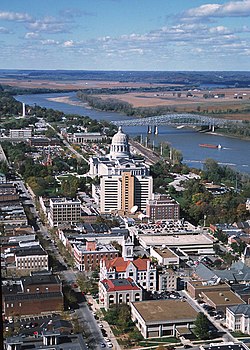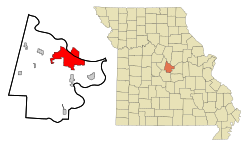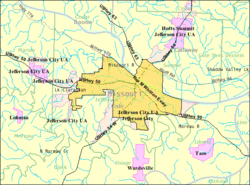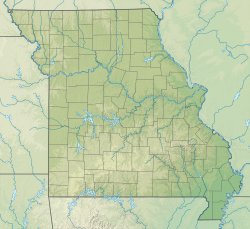Jefferson City, Missouri
Jefferson City is the capital of the U.S. state of Missouri. It is also county seat of Cole County. (The Jefferson City metropolitan area includes Callaway, Cole, Moniteau, and Osage counties.) As of the 2020 census, the population was 43,228.[7] Jefferson City was named after Thomas Jefferson, the third president of the United States.
Jefferson City | |
|---|---|
State capital and city | |
 | |
| Nickname: Jeff[1] | |
| Motto: Jefferson City | |
 | |
 U.S. Census Map | |
| Coordinates: 38°34′04″N 92°10′33″W / 38.56778°N 92.17583°W | |
| Country | United States |
| State | Missouri |
| Counties | |
| Founded | 1821 |
| Incorporated | 1825 |
| Named for | Thomas Jefferson |
| Government | |
| • Type | Mayor–council |
| Area | |
| • State capital and city | 37.65 sq mi (97.51 km2) |
| • Land | 36.05 sq mi (93.38 km2) |
| • Water | 1.60 sq mi (4.13 km2) |
| Elevation | 630 ft (192 m) |
| Population (2020) | |
| • State capital and city | 43,228 |
| • Density | 1,198.98/sq mi (462.93/km2) |
| • Metro | 150,309 |
| Time zone | UTC−6 (CST) |
| • Summer (DST) | UTC−5 (CDT) |
| ZIP codes | 65101-65111 |
| Area code | 573 |
| FIPS code | 29-37000[6] |
| GNIS ID | 758233[5] |
| U.S. Routes | |
| State highways | |
| Waterways | Missouri River |
| Website | jeffersoncitymo.gov |
Jefferson City is near the center of Missouri, a region known as Mid-Missouri. It is on the northern edge of the Ozark Plateau on the southern side of the Missouri River. It is at the western edge of the Missouri Rhineland, one of the major wine-producing regions of the Midwest.
History
changeIn pre-Columbian times, this region was home of an ancient people known only as the Mound Builders. By the time European settlers began arriving, the Mound Builders had vanished into history. The contemporary indigenous peoples were called the Osage Indians. When the Missouri Territory was organized in 1812, St. Louis was the seat of government. St. Charles next served as the capital.
The new state legislature decided to build a new capital city in the middle of the state in 1821. They named it after Thomas Jefferson, who was still alive. A village was already there called Lohman's Landing.[8] For years the village was little more than a trading post located in the wilderness about midway between St. Louis and Kansas City. In 1826 the Missouri legislature first met here and in 1839 the settlement was incorporated as a city.
Jefferson City was selected as the site for a state prison and, in 1836, the Missouri State Penitentiary was opened. The prison was home to a number of infamous Americans, including: former heavyweight champion Sonny Liston, assassin James Earl Ray, and bank robber Charles "Pretty Boy" Floyd.
During the American Civil War, Jefferson City was occupied by Union troops. Many of the people in the state supported the Union, although Missouri's Little Dixie section along the river in western counties was strongly Confederate.
German immigrants created vineyards in small towns on either side of the Missouri River, especially on the north from Jefferson City east to Marthasville outside St. Louis. This area is known as the Missouri Rhineland after the Rhineland in Germany. It has grown as an agricultural and tourist economy.
Geography
changeJefferson City is located at 38°38′58″N 92°12′52″W / 38.64944°N 92.21444°W (38.572954, -92.189283).[9] According to the United States Census Bureau, the city has a total area of 28.3 square miles (73 km2). Of that, 27.2 square miles (70 km2) is land and 1.0 square mile (2.6 km2) (3.61%) is water.
Education
changeJefferson City is served by the Jefferson City Public School District, which operates Jefferson City High School and Capital City High School, Lewis and Clark Middle School and Thomas Jefferson Middle School, and eleven elementary schools. There are 4 private elementary schools: St. Joseph's Cathedral, St. Peter, Immaculate Conception, and Trinity Lutheran. Calvary Lutheran, Helias Catholic, and Lighthouse Preparatory Academy are Jefferson City's private high schools.
Lincoln University is a public historically black university with open enrollment and certificate, associate, bachelor, and graduate programs. Columbia College, Linn State Technical College, William Woods University, Metro Business College, and Merrell University also have locations in Jefferson City with varying degree levels and options.
Transportation
changeJefftran operates a public bus system year-round.[10] Jefferson City is one of four state capitols in United States that are not served by an interstate highway.[Note 1] Only four other state capitols nationwide share in this oddity. Interstate 70 passes by the city 30 miles (48 km) to the north, in Columbia. U.S. Highways in the city include U.S. Route 50, U.S. Route 54, and U.S. Route 63. Also Route 179 and Route 94 run through the city, giving it four highways that intersect with I-70. Jefferson City is also home to an Amtrak station.
Notable Citizens
change- James T. Blair, Jr. was the mayor of Jefferson City in 1947 and then later a governor of Missouri.
- Lorenzo Greene Lincoln University faculty and civil rights pioneer
- Jack S. Kilby was born in Jefferson City.
- Cedric the Entertainer (Cedric Kyle) was born in Jefferson City.
- William Rose (screenwriter) was born in Jefferson City.
Notes
change- ↑ Pierre, South Dakota; Dover, Delaware; and Juneau, Alaska are the other four state capitals without interstate highways.
References
change- ↑ "Capitol of Missouri – Jefferson City ***". www.spangledwithstars.com. Archived from the original on 8 January 2017. Retrieved 9 June 2017.
- ↑ "Contact the Mayor". Archived from the original on May 7, 2006. Retrieved 2010-09-19.
{{cite web}}: CS1 maint: bot: original URL status unknown (link) City of Jefferson. Retrieved on May 21, 2010. - ↑ "Jefferson City — Departments". Archived from the original on 10 September 2014. Retrieved 9 June 2017.
- ↑ "ArcGIS REST Services Directory". United States Census Bureau. Retrieved August 28, 2022.
- ↑ 5.0 5.1 "Geographic Names Information System". edits.nationalmap.gov. Retrieved 2023-05-08.
- ↑ "U.S. Census website". United States Census Bureau. Retrieved 2012-07-08.
- ↑ "QuickFacts: Jefferson City city, Missouri". United States Census Bureau. Retrieved March 13, 2024.
- ↑ McMillen, Margot Ford & Murphy, Dennis. A to Z: The Dictionary of Missouri Place Names. Columbia, MO. Pebble Publishing, 1996. ISBN 978-0-9646625-4-4.
- ↑ "US Gazetteer files: 2000 and 1990". United States Census Bureau. 2005-05-03. Retrieved 2008-01-31.
- ↑ "Archived copy" (PDF). Archived from the original (PDF) on 2010-02-15. Retrieved 2011-11-27.
{{cite web}}: CS1 maint: archived copy as title (link)
Other websites
change- http://www.jeffcitymo.org/ Archived 2005-05-12 at the Wayback Machine Jefferson City, MO (Official Webpage)
- Jefferson City Convention and Visitor's Bureau


